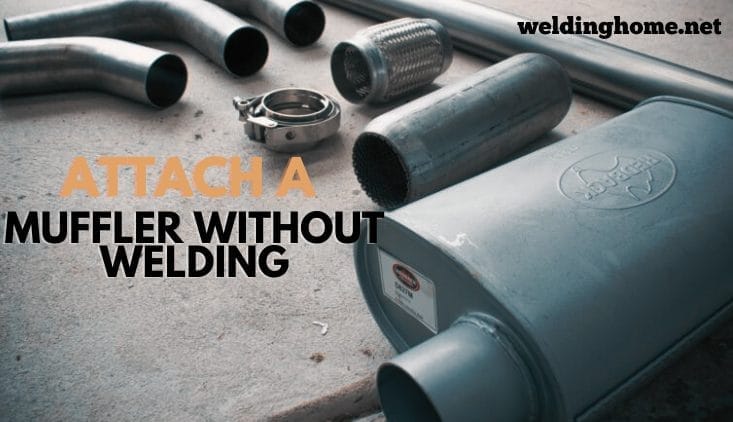How to Attach a Muffler Without Welding? 3 Easy Tips and Tricks

When people customize their cars, one of the most popular upgrades is to change or replace the exhaust system. A muffler is an essential part of the exhaust system and plays a significant role in improving the sound and speed of the car. Welding is often used to connect mufflers firmly, but only some have access to or How to Attach a Muffler Without Welding? Tips and Tricks. Luckily, there are other ways to connect a muffler besides welding. I’ll go over these do-it-yourself methods step by step in this piece.
Required Tools and Materials to Attach a Muffler Without Welding
Before diving into the methods, make sure you have the following tools and materials ready:
- Muffler clamps
- Hangers
- Exhaust cement
- Safety gloves and goggles
- Jack stands
- Wrench and socket set
- Measuring tape
Method 1: Using Muffler Clamps
- You can connect a muffler without cutting with muffler clamps, which are flexible and easy to use. How to do it:
- Get the car ready: To be safe, park it in a flat area, put on the parking brake, and lift it with jack stands.
- How to Measure and Place: Find out how big the muffler and pipes are. Pick out an exhaust clamp that is the right size. Put the muffler where it needs to be.
- Put the clamp on. Place the muffler clamp over the part where the tailpipe and muffler meet. Use a tool to tighten the clamp.
- Secure with Hangers: To support the muffler’s weight and stop it from moving or shaking too much, use exhaust hangers.
- Check for Leaks: Start the car and look for any gas leaks. If you see any, move the clamps around and fix them as needed.
Method 2: Using Exhaust Cement
Exhaust cement is a viable alternative technique for affixing a muffler without welding. The following instructions outline the process:
- Safety is of utmost importance and warrants careful consideration and analysis.
- Preventive measures: Before commencing, it is essential to don safety gloves and eyewear.
- Surface Cleaning: Verifying that the muffler and tailpipe are devoid of corrosion or dirt is crucial. If deemed essential, use a wire brush.
- Utilize the Cement: Administer a substantial quantity of exhaust cement to both the entrance of the muffler and the tailpipe.
- Integrate the Components: Carefully attach the muffler to the tailpipe, ensuring the cement is uniformly distributed between the two elements.
- To ensure a secure connection, it is recommended to use muffler clamps, which provide additional support.
- Facilitate the Curing Process: Adhere to the prescribed duration for the curing of the exhaust cement, as specified in the product’s instructions.
Method 3: Using a Custom Hanger
Designing a personalized hanger is a viable solution for affixing a muffler without resorting to welding techniques. The following instructions outline the process:
Identify Attachment Points: This task aims to identify the attachment points. Identify anchorage locations on the automobile’s chassis or frame to suspend the muffler.
Measure and Cut: The process of measuring and cutting. Determine the necessary dimensions and configuration of a metallic rod or wire. Trim the object to an appropriate size, guaranteeing its ability to support the muffler firmly.
Attach the Hanger:
- Securely fasten the hanger.
- Manipulate the metallic rod or wire into a configuration resembling the letter “U” and attach it to the exhaust system’s muffler.
- Fasten it securely to the designated connection locations using bolts and nuts.
Stability Assessment: It is vital to ascertain the stability of the muffler and prevent it from hanging too low, as this might pose a danger of damage during vehicular operation.
Does tape for the exhaust work?
A popular way to fix small holes or cracks in your muffler or exhaust system is with muffler tape, also called exhaust tape. It might work for short-term fixes of minor problems but won’t fix more significant issues in the long run. Muffler tape is often used to stop small leaks and short-term quiet down vehicles. But if there are more important problems, like big holes or damage to the structure, you should get it fixed by a professional or consider getting a new one. So, muffler tape can help in some cases, but how well it works depends on how bad the damage is.
Conclusion
In conclusion, there are a number of do-it-yourself ways that can be used to connect a muffler without cutting. Whether you like how easy muffler clamps are to use, how strong exhaust cement is as a glue, or how a custom hanger works, these methods can save you time and money while making sure your car’s exhaust system works right. Don’t forget to take safety steps and check for problems often.
Get ready to improve the exhaust system on your car without having to fix anything. You can now enjoy a better ride and an excellent engine sound.
FAQ’S
Is putting on a muffler without welding safe?
If you do it right, yes, it’s safe. Make sure that all of the parts are firmly connected and that they are checked for problems on a frequent basis.
Why would you want to use exhaust cement?
Using exhaust cement between the muffler and the tailpipe makes a strong seal that lowers the chance of leaks.
Can I put muffler clamps on any car?
Yes, muffler clamps can be used on a lot of different cars.
Are there any changes in how well welding and other ways work?
Soldering might work a little better, but most drivers can get by with ways that don’t involve soldering.
How often should I check the connection to my muffler?
Every few months or after driving in rough weather, you should check your muffler connection to make sure it’s tight and doesn’t leak.



